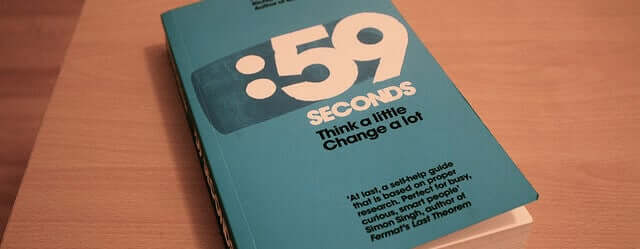Review by Tom Hudson
You don’t have to read very far into 59 Seconds: Think a Little, Change a Lot (Amazon), before you realize that Richard Wiseman is a man who does his homework. Shortly after his encounter with Sophie, a bright, successful management consultant, the author describes collecting hundreds of behavioral research studies on the subject of increasing happiness. He shows that he is not afraid to get his own hands dirty and is as capable of conducting his own research as he is shining light on the work of others. As the title suggests, this is a self-help book, the aim of which is to equip readers with simple and effective techniques for making significant changes in their lives. One by one, Wiseman dispels common myths about how to achieve happiness, the mysteries of attraction and relationships, effective parenting and other key aspects of the human condition.
Material is broken down into ten chapters along with an introduction and a conclusion. Through the judicious use of humor and wit, each chapter ends with a 59-second blueprint for navigating the minefield of life. The book encapsulates hundreds of scientific behavioral studies, often with counterintuitive results. The chapters cover practical methods for achieving success at:
HAPPINESS – Contrary to popular opinion, positive thinking often fails. The real path to happiness is discovered by using a pencil, a diary, consciously expressing gratitude and small acts of kindness. One of the great quotations that the reader will remember in the weeks, months and years to come is that, “about 50 percent of your overall sense of happiness is genetically determined, and so cannot be altered.” Ten percent is due to circumstances and, “the remaining 40 percent is derived from your day-to-day behavior.” Also, writing about our deepest feelings offers a more structured and constructive approach to dealing with traumatic issues than the more chaotic and disorganized approach of talking them out. It also turns out that performing simple acts of kindness for other people can contribute to our sense of happiness. Interestingly, this effect is more pronounced when the acts are all carried out on one day each week, as opposed to performing one benevolent act each day.
PERSUASION – The reader discovers why rewards often fail, how making mistakes and wearing a Barry Manilow T-shirt can improve social interactions, and how not to ever lose a wallet. Advice is offered on how to give the perfect job interview. Rewards often fail because, when offered a lavish reward for performing a task, we interpret the size of the reward with a bribe to do something we don’t enjoy. Excessive rewards, therefore, have a detrimental effect on the attitudes of those who are being persuaded to complete a task. Persuasion is better achieved by ‘putting your foot in the door, understanding groupthink.’ Moreover, it turns out it really is better to give than receive.
MOTIVATION – In the same way that positive thinking can lead to failure, there is also a dark side to the technique of positive visualization. On the plus side, anything can be achieved by creating a perfect plan, and it really is possible to overcome procrastination (today). Visualization fails because those who get carried away fantasizing how wonderful life will be once they achieve their goal of losing weight, meeting the love of their life or getting the perfect job are unprepared for the challenges they encounter frequently along the way.
CREATIVITY – This chapter begins by explaining why brainstorming, a problem-solving technique that has been in use for more than seventy years has, instead, been stifling creativity rather than fostering it. Perhaps the best news is that there are times when the correct approach to stimulating the thinking process comes from lying down on the job. Creativity is one key area where where our subconscious brain is more effective at problem-solving than our overt, conscious thinking power. In another memorable gem, the author suggests that, to get in touch with our “inner Leonardo da Vinci, … all it takes is a glance at the right type of modern art, lying down on the job, doing nothing or putting a plant on your desk.”
ATTRACTION – Here, the author explains how rollercoaster rides, a simple touch and pizza toppings offer a greater chance at success in attracting the opposite sex than the time-honored practice of playing hard to get. It was the Greek philosopher Socrates who introduced the concept of ‘treating them mean and keeping them keen.’ In this section of the book, the reader learns about the science of speed dating and how to construct the perfect date. This chapter contains amusing descriptions of scientifically-designed studies on the role of breast size in determining a woman’s attractiveness. Experiments that have been carried out on the power of touch are also shared. The gist of this work is that a light touch on the upper arm can convince someone to help you with a task; use this information carefully because a few centimeters in the wrong direction can land a person in trouble.
STRESS – Wiseman opens this chapter with an explanation of our continual inner struggle between the devil on one shoulder (our id) and the angel on the other (our superego) while our inner mediator – the ego – attempts to keep the peace between the two. Most of the time, the ego is able to maintain harmony, with sporadic outbreaks of sex and violence when the delicate balance breaks down. When this occurs, we learn that owning a dog, rather than screaming into a pillow, is the way to dispel rage and relieve frustration.
RELATIONSHIPS – This chapter is aimed at couples and romantic entanglements, rather than relationships with co-workers, friends or relatives. When it comes to our nearest and dearest, words actually speak louder than actions, active listening doesn’t work and relationships may be held together with photographs and Velcro. When it comes to romance, it ‘really is the thought that counts.’ Women are more likely to respond to surprise and escapism than they are to materialism. Another take-home message is that it takes five acts of support or kindness to undo the damage caused by a single harsh word.
DECISION MAKING – This chapter opens with a discussion on how working in a group can bring out the worst when it comes to reaching a valid consensus. Later, the author further develops the theme of allowing the subconscious mind to do its job without interference. Sometimes thinking too hard about a problem is just as bad as making a knee-jerk decision. While the conscious mind is perfectly capable of analyzing a situation in a rational manner to determine the best course of action, it is our subconscious brain that has the ability to juggle the more complex problems and provide a balanced decision.
PARENTING – Can exposing our children to the music of Mozart boost their brainpower? Find out here. With reference to a seminal study in 1993 that ‘changed the world, ‘ Wiseman reveals that yes, it can. College students who were exposed to Mozart’s Sonata for Two Pianos in D Major performed significantly better on a spatial manipulation test than did those students who listened to a standard relaxation tape or sat in total silence. This effect was repeatable and long-term. That being true, the benefits did not replicate themselves when similar tests were performed on infants. Responding to what was little more than urban legend, education authorities in the states of Georgia and Florida actively promoted the exposure of babies and young children to classical music. One state, Georgia, distributed free classical music CDs to mothers of newborn children while Florida passed a bill that required day-centers in receipt of state funding to play classical music to their tiny charges on a daily basis.
PERSONALITY – The final chapter opens with an amusing anecdote about how the world’s graphologists spectacularly failed to correctly analyze the handwriting and doodles on a sheet of paper that had apparently been left behind by the then-British Prime Minister, Tony Blair, following an international summit on the world’s biggest problems. Delving further into the chapter, the reader discovers that more accurate information about an individual’s personality can be ascertained by reading their bumper stickers than by the ‘science’ of graphology. Large-scale studies beginning in the 1930s and concluding in the early 1990s eventually revealed what are collectively referred to as the ‘Big Five, ‘ the five dimensions of personality. Apparently, we can all be described by five scores indicating where we fall on each scale.
SUMMING UP
The benefits of putting the unconscious mind to work are introduced in the chapter on Creativity. Using the example of Salvadore Dali dropping a spoon into a glass, he instructs us to ‘listen to the quiet guy.’ This theme is developed further in the chapters on Attraction and Decision Making. The text is peppered with occasional quizzes that the reader can easily take and score without becoming distracted from the message at hand. To further break up the text and emphasize his message, the author weaves in wisdom from Dostoevsky, Freud, Socrates and Ovid, among others.
Richard Wiseman is a gem of an author. He successfully meets the challenging task of synthesizing simplicity out of the driest academic studies in human behavior. His prose is punctuated with just enough humor to keep the reader awake before there is any danger of falling asleep or losing interest. Best of all, he plows through a century or more of behavioral research and condenses it into conveniently digestible portions on how to change our lives, for the better, in less than a minute. If the foregoing has been sufficiently creative, motivating and persuasive, you, too, can gain this wisdom by reading the book yourself!
Get your copy of 59 Seconds: Think a Little, Change a Lot | Amazon





